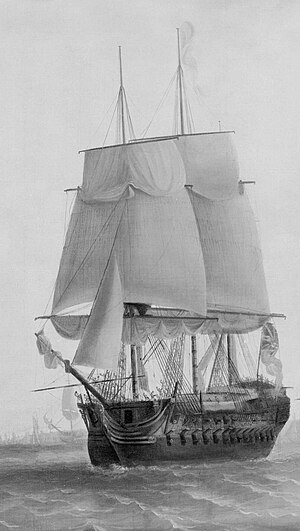 HMS Carnatic off Plymouth, 18 August 1789
| |
| History | |
|---|---|
| Name | HMS Carnatic |
| Ordered | 14 July 1779 |
| Builder | Dudman, Deptford Wharf |
| Laid down | March 1780 |
| Launched | 21 January 1783 |
| Renamed | HMS Captain, 1815 |
| Fate | Broken up, 1825 |
| General characteristics [1] | |
| Class and type | Courageux-class ship of the line |
| Tons burthen | 171930⁄94 (bm) |
| Length | 172 ft 4+1⁄2 in (52.5 m) (gundeck); 140 ft 5+1⁄4 in (42.8 m) (keel) |
| Beam | 48 ft 0 in (14.6 m) |
| Depth of hold | 20 ft 9+1⁄2 in (6.337 m) |
| Propulsion | Sails |
| Sail plan | Full-rigged ship |
| Armament | |
HMS Carnatic was a 74-gun third rate ship of the line of the Royal Navy, launched on 21 January 1783 at Deptford Wharf.[1] The British East India Company paid for her construction and presented her to the Royal Navy.[2]
Sometime prior to 16 September, 1799 the American schooner "Violet" was capsized and sunk by a waterspout at (27°30′N 62°00′W / 27.500°N 62.000°W). 14 days later they were rescued by Carnatic. Four perished during the ordeal.[3]
On 11 May, 1801 she, in company with HMS Sans Pareil and HMS Cumberland, made contact with USS Ganges in the West Indies, Lat 22.01 N.[4]
On 17 May 1815, the Admiralty renamed her HMS Captain. Captain was broken up on 30 September 1825.[1]
- ^ a b c Winfield (2008), p.57.
- ^ Hackman (2001), p.227.
- ^ "Naval Documents related to the Quasi-War Between the United States and France Volume Part 1 of 3 Naval Operations August 1799 to December 1799 August to September Pg. 191" (PDF). U.S. Government printing office via Imbiblio. Retrieved 20 May 2024.
- ^ Naval Documents related to the Quasi-War Between the United States and France (PDF). Vol. VII Part 1 of 4: Naval Operations December 1800-December 1801, December 1800-March 1801. U.S. Government Printing Office. p. 225. Retrieved 25 September 2024 – via Ibiblio.